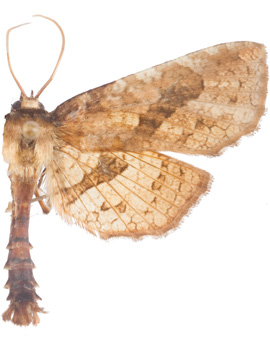Scientific classification
Animalia > Arthropoda > Insecta > Lepidoptera > Ditrysia > Thyridoidea > Thyrididae > Siculodinae > Siculodini > Sinecalca
Genus Sinecalca Whalley, 1971a
Type species: insolita Whalley, 1971a: 173, by original designation, is from the Southern Highlands of Tanzania (Ugano). It is in the NHM (Mi7354) genitalia slide #10107.
Generic description: Proboscis reduced. Eyes without interfacetal hairs. Labial palpi three segmented. Antennae ciliate or monopectinate. Fore tibiae may have an epiphysis. Hind tibiae with one or two pairs of spurs. A tibial strigal is absent. Tarsi without spines. R vein from cell or with R3 + R4. Gnathos in males is a weakly sclerotized arch. Female without signum in bursa. Whalley noted the absence of a frenulum in both sexes as distinctive (Whalley, 1971a:30, 32, 172). However a frenulum is present in S. capotona (see below), which has only recently been recognized as a being in this genus. Ms. comb. n. (Shaffer, 1991, LepIndex). This species may not be correctly assigned to this genus and a re-assessment of the species is desirable in view of the disjunct generic distribution.
There are currently only three species in the genus; two from Central Africa (S. confusa Whalley, 1971a) from Kenya & Democratic Republic of Congo, and S. insolita Whalley, 1971a from Tanzania). Remarkably there is a species in SE Asia, S. capotana. All are large brown leaf mimics with a distinctive morphology and wing shape (Whalley, 1971a).

